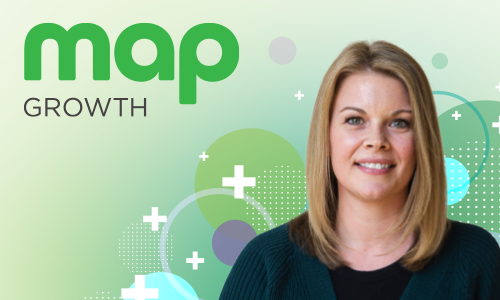 One thing educators could always use more of is time. That is top of mind here at NWEA, especially when it comes to how many questions are on the MAP® Growth™ assessment. How can we get accurate, actionable data in the hands of educators like you while still preserving your instructional time?
One thing educators could always use more of is time. That is top of mind here at NWEA, especially when it comes to how many questions are on the MAP® Growth™ assessment. How can we get accurate, actionable data in the hands of educators like you while still preserving your instructional time?
Educators, who often design their own assessments, also balance these questions:
- How many questions do I need to evaluate student understanding? Teachers know that five multiple-choice questions is inadequate to assess a whole unit, but 100 questions is probably excessive.
- How long will the average student spend on this test? Veteran educators know how to design a test that will last a desired amount of time. We don’t want fast finishers completing a summative assessment in ten minutes, and we also don’t want half the class returning after school to complete a test.
These questions—among many others—guide the design of our MAP Growth test. Luckily, our team of researchers is behind our answers.
How many questions are on the MAP Growth assessment?
In the summer of 2022, we updated MAP Growth to standardize all versions to 43 questions. This update significantly reduced the number of items of some tests, such as the Spanish math test, which saw a reduction of 12 items. This cut testing times significantly, providing teachers with a more predictable range of assessment times.
After three testing sessions in the fall, winter, and spring of the 2022–23 school year, our team analyzed the results and uncovered these key findings:
- The overwhelming majority of MAP Growth tests are completed in 40–55 minutes.
- Across all grades and testing periods, average test duration decreased by 7–10 minutes—roughly a 17% decrease.
- There is now less test duration variability, with the highest average duration being 58 minutes (5th grade, spring 2023) and the lowest being 25 minutes (kindergarten, spring 2023).
Want another nerdy detail? Our researchers concluded that 43 items is a sufficient amount of test items to preserve a valid standard error of measurement (SEM) range, meaning it’s the just-right number of assessment items to gauge a student’s RIT score. Fewer questions might save more time, but the data would become less reliable—and that’s not what we’re about at NWEA. (If you’re feeling frustrated about how much time is spent on assessment, our video “Why should I test so much when I could be teaching?” can help.)
But why do some of my students still take so long to test?
There are always students who take longer to test, no matter the assessment format. Finding the middle ground between fast finishers and test lingerers is both an art and a science! When it comes to the MAP Growth assessment, here’s what you should keep in mind:
- MAP Growth is designed for students to get 50% of questions wrong. This means that no amount of extra time spent on a question will necessarily allow a student to “figure it out.” Teachers, be sure to explain to all students that the test is supposed to feel difficult. This is by design and allows the assessment to find exactly where a student is in their learning. Consider showing your students our video “Is your MAP Growth score good?” and remind them—especially high achievers, who are used to puzzling out harder problems—that many of the questions are supposed to be a little too hard.
- There is such a thing as too fast, and our software detects it. Rapid guessing is when a student flies through a test, primarily due to disengagement. While MAP Growth will slow students down with a visit from Slow-Down Sloth, teachers and proctors can greatly help with this by explaining the value of the test to students. Explain the above point, that some items might feel too difficult, while others will feel just right. Help students understand the value of this data.
- Longer reading passages may slow down older students. Higher Lexile levels and word counts mean longer reading times, as students encounter more sophisticated vocabulary, structure, and ideas. Even with this level of difficulty, the longest average test time was 50 minutes (11th grade, spring 2023).
- More complex questions may affect high-performing students. As the computer adapts to students at a higher level, providing them with questions of increasing difficulty, the math and reading become more complex. While this may make the student take longer to answer, this increase should only be slight. Again, remind high-achievers that the test is trying to find questions that are a bit too difficult and that there is no perfect score on MAP Growth.
A helpful metaphor for students
Think of the MAP Growth assessment as a racetrack with progressively taller hurdles. Students might easily clear the first few and will have to exert more effort as the hurdles get taller. However, at some point, a hurdle will be too high for a student to clear. The point of the test is to find out the height of the ideal Goldilocks hurdle: just right.
Now, what if a runner stopped the race and stood in front of a hurdle for five minutes, trying to figure out how to jump over it? They might eventually clear it but, in doing so, they’ve missed the point of the race.
It’s all about balance
You know designing a rich assessment involves trade-offs. It’s certainly easier to author and grade a short multiple-choice test, especially when that means we can start our next unit on time, but deeper assessment methods yield a more accurate result of student understanding that can save you time in the long run by helping you better understand how to differentiate instruction and set learning goals with students.
When it comes to student growth, you crave a balance of trustworthy data and plenty of instructional time. At NWEA, we aim for balance as well, creating a reasonable assessment duration that finds a student’s true ability level: not too hard and not too simple. And it turns out, 43 items is just right.
To read more related articles here on Teach. Learn. Grow., visit our archive of assessment posts and archive of posts on using MAP Growth data in the classroom. Looking to bring the MAP Growth assessment to your school or district? Contact our sales team.






